In this article, we’re going to share everything you need to know to start wet wading. We’ll show you all the best types of gear and the smartest safety tips to make this method of wading your new favorite. Leave your chest waders at home, because it’s time to get wet!
Quick Navigation:
Why Wade? | Wet Vs Dry Wading | Safety Tips | Wading Gear
Do I Need To Wade?
Whether you’re an old hand or brand new to the sport, one thing that all fly fishers know is that you can only get so far if you stay onshore or even drifting in a boat. Only by getting in the water (wading) do you have the true freedom of movement you need to put your fly exactly where you want it. It becomes much easier to change angles for better drifts when you’re in the stream. Instead of trying for a nearly impossible cast, you can step in the water, or even cross the river to give yourself a better angle of approach. You’ll find the top anglers explaining that your feet are the best mending technique. The more you move to position yourself correctly, the easier it becomes to present flies.
Wading also makes long casts much less frustrating. When fishing from the bank, long casts tend to end up in the weeds, trees, or rocks as the tip of the rod goes behind you. Casting from the middle of a stream can significantly reduce this issue.
The question then becomes: wet wading or dry wading? In cold weather, this is an obvious choice. If it’s winter, do not wet wade. Keep yourself warm and dry and avoid hypothermia. But wet wading is a great option for warm weather, and with our helpful tips, you’ll be wet wading like a pro in no time.
Wet Wading vs. Dry Wading
For many people, the classic image of a fly fisher is someone standing in the middle of a stream, the straps, and waist of their waders visible above the hip-deep water. Dry wading requires either high waterproof boots, a chest-height waterproof overall (waders), or even a full-body coverage dry suit depending on the water conditions. In cold weather, waders are a must-have to keep the skin dry and to avoid hypothermia.
But when it’s hot out, the idea of those bulky, heavy waders becomes less and less appealing. This is where wet wading wins out. Chest waders and high wading boots are typically made from vulcanized rubber, PVC, GORE-TEX, or neoprene, none of which are very comfortable on a hot day. When you wet wade, you hop into the water wearing whatever you want. The reduction in gear means increased agility and maneuverability, as well as greater comfort overall.
Wet wading tends to make hiking into a location a bit easier due to less weight, and not needing comfortable enough waders and wading boots to hike longer distances.
Some anglers also appreciate the freedom that wet wading brings. When you don’t have to carry your waders with you, you have more options about where and when you can go fishing. You can just grab your rod and hike out, as opposed to having to pack heavy gear. Many anglers feel a deeper connection to nature when they can feel the water in the stream, which can bring a high degree of enjoyment and relaxation to the sport.
| Wet Wading | Dry Wading | |
|---|---|---|
| Weight | Lighter gear | Heavier gear (waders and wading boots) |
| Cost | Generally less (can often wet wade without additional purchases) | Need to purchase waders and wading boots (or boot waders) |
| Comfort | Generally more comfortable in hot conditions or when hiking is necessary | More comfortable in colder conditions |
| Seasons | Only warm conditions | Year round use |
Wet Wading Safety & Tips
Wet wading is just as safe as dry wading, but just like all kinds of fishing, you need to be prepared! Here are some wet wading tips to improve your wading safety and enjoyment. Also, read our wading safety tips article.
Avoid Natural Fiber
Cotton and denim are great for keeping you cool when you’re dry, but they will weigh you down substantially when they’re wet. They also take forever to dry, making the hike back a miserable experience. You want to look for clothes made with sweat or water-wicking fabrics, as these will dry much more quickly and perform better in the water.
Don’t Just Go With The Flow
Stand sideways to the current and avoid facing directly upstream or downstream. When moving across a stream, keep yourself at an oblique angle and lead with your downstream foot to stay upright. Be very careful with your foot placements and try to avoid any algae-covered, slippery rocks– otherwise, your wet wading expedition might turn into an unwanted swimming trip!
Pay attention to your stance, too. Keep your feet at least as wide apart as your shoulders while you’re walking, and never cross your feet while you’re moving in the water. A wide base is more stable and less likely to capsize. Bend your knees a little bit to lower your center of gravity, too– this will help you keep your balance in faster waters.
Don’t Be Invasive
Avoid transferring invasive species! This isn’t just for your safety (you can be fined if the game warden inspects your gear and finds invasive species on it), but for the safety of the waterways as well. Invasive plants and the larvae of invasive invertebrates can hitch a ride on your shoes, particularly if you’re using shoes with laces or webbing straps.
Invasive species transfer is also one of the main reasons that felt-soled wading footwear is becoming less popular. While felt provides traction, it’s far too easy to transfer invasive plants with a felt-bottomed boot. Stick to rubber soles, and if you’re worried about the grip, you can always add spikes or grip bars to the bottom of your shoes.
Be sure to wash your gear between waterways, and if you want to make sure that there’s no chance of invasive hitchhikers. Generally drying gear for 48 hours will kill most invasive species, but if transferring bodies of water quicker than that, you should be rinsing down your gear and disinfecting your gear to kill anything that could be on your gear.
Check The Temperature
Watch the water temperature. When your wet wading, it generally means temperatures are higher. Water above 65 degrees F may not be suitable for fishing. Bring a thermometer with you, and if you are fishing for cold water species like trout, avoid waters that have high temperatures. Fishing in these temperatures may kill trout.
Invest In Good Footwear
Supportive footwear is the single most important element of wet-wading safety. There are lots of good options out there in numerous styles, so pick the style that makes you feel most comfortable. However, you must take care to pick appropriately sized and appropriately supportive footwear to keep yourself safe in the stream. Many anglers will buy specialized wet wading gear (discussed below) while others will take a trail running shoe or even sandals to the water to wet wade in. The best for you depends upon preference, conditions, and needs for hiking / walking distances.
Wet Wading Safety Gear
There are a few items that all wet waders should carry for their safety. We’ll talk about footwear picks in just a little bit, but before we do, here are four things that may keep you safer in the water.
Wading Staff
Wading staffs are most frequently used by older fly fisherman to stabilize while moving across water. They greatly enhance stability, reduce fall risk, and therefore are a must have for anyone who is considering wading in fast moving water, or water with difficult footing. Younger anglers should be bringing wading staffs as well for safety purposes.
When choosing a wading staff, look for a collapsible one with a built-in gear keeper retractor, like the Orvis Ripcord Wading Staff, which will allow you to simply stow it away after you’ve gotten settled.
Bag Balm
If you’re going to be standing in the water all day, you must protect your feet. Lengthy submersion, even with neoprene socks, means that your feet are going to get wet. Prolonged exposure to wet conditions puts you at risk for trench foot or at least uncomfortable skin damage if you don’t take care of your feet. After you get out of the water, clean and dry your feet, and apply a protective cream to reduce inflammation and irritation. Bag Balm is the gold standard for this application.
Sun protection
Did you know that 9 out of 10 cases of melanoma are caused by UV exposure? Nobody wants skin cancer, and the best way to protect yourself from the painful short-term (think sunburn) and long-term effects of the sun is to wear sunscreen. There are many good options out there, but the most effective sunscreens have an SPF of at least 30. Since you’ll be in the water, you want a water-resistant formula. Our guide to sunscreen selection has all of the information you need to make an informed decision on what type of sunscreen to use.
You should wear a wide-brimmed sun hat and a lightweight, long-sleeved shirt to protect your skin with or without sunscreen.
Polarized sunglasses
We’ve talked about the benefits of polarized sunglasses before. They aren’t just there to help you find fish– they provide important safety benefits. First, they’re eye protection against errant flies. Everyone has a miscast from time to time, and you can’t help getting caught in snags. Having something covering your eyes helps keep them safe from flies and the hooks within when you’re in a sticky situation. Secondly, polarized sunglasses cut down on glare, making it easier to see potential hazards in the water like logs, big rocks, or drop-offs.
Wet Wading Gear
Now that you’re a wet-wading safety guru, it’s time to talk about gear! While you can buy specific gear for wet wading, you might be surprised to learn that you already have some of the gear you need to get in the water. You don’t need a specific type of shirt or pants, for instance– just wear what’s comfortable when wet. If you just want to dip your toe into the world of wet wading, sturdy sandals like Tevas or Chacos work well. You could even use your trail running shoes or a basic pair of water shoes. Just make sure that whatever shoes you use have sturdy soles.
For instance, I most frequently wade wearing my trail running shoes that have a sturdy sole, amazing grip, and I simply utilize merino wool or a synthetic blend athletic sock.
However, if you’re serious about wet wading, or want to keep your feet a bit more dry for long durations, there are some specific gear types to pay attention to. Footwear is the most important, but that doesn’t just mean shoes, boots, or sandals. You need to make sure that you have good wading socks as well. You also need solid, durable waterproof storage. Here are our picks for the best wet wading gear on the market.
The Best Wading Socks
While you can jump into the water barefoot, we don’t recommend this. With sandals, anglers won’t be utilizing socks, with regular shoes or trail runners, wet waders will use a classic athletic sock that is moisture wicking, and if utilizing wading boots, anglers will want to utilize wading socks. Here, we will discuss both regular socks, and wading socks.
Rivers and streams are full of debris and gravel, and you don’t want these buffeting your feet! While most wet waders don’t wear socks or gravel guards with their sandals, if you’re wearing wading boots, wading socks are a must-have to prevent chafing, rocks and gravel from damaging your feet, and to maintain a better fit in your wading boot.
When wearing a wading boot, or regular shoe we highly recommend getting a gravel guard or ankle gaiter to prevent rocks and gravel from entering the tops of the boots.
Classic Socks
If you’re wearing shoes instead of boots, you might find that neoprene socks are just too thick. In this case, you will want a traditional sock (not 100% cotton). You will also want to wear socks under your neoprene anyways to help prevent chafing. Choose socks that are ankle length or taller– this is not the place for footies. And while your old crew socks might technically work, a more rugged sock designed for outdoor sports is more likely to offer your feet the comfort and protection they need.
For traditional socks, simply look for materials that say moisture wicking. Synthetic blends, merino wool, and other materials can do this quite well, and you likely have socks in your drawer already that will work great for wet wading. Here are some examples of more ideal style socks:
Any Fox River hiking sock. Made in the USA, these socks are super high quality, moisture wicking, durable, and comfortable. We wear them wet wading in rivers on a weekly basis. Check out our review of Fox River Socks.
The Sealskinz Waterproof Warm Weather Mid Length Sock With Hydrostop (or here) is designed to be comfortable in warm weather and offers a great deal of protection. These socks are higher-end gear, priced at a little under $50, but they have a feature that might truly improve your wading experience: Hydrostop. This is a silicone-like lining in the upper portion of the sock that is meant to keep water from entering the top of the sock. But for a wet wader, this has the bonus effect of acting like a gravel guard.
Bombas Men’s Performance Hiking Calf Socks are a traditional sock that uses moisture-wicking materials– meaning they dry quickly. They also have fully cushioned feet for maximum comfort. They’re thin enough to be worn under a gravel guard and should dry quickly enough that you can hike back out without much of a fuss. And at less than $20 a pair (with multipacks that are even more cost-effective), you could even throw an extra pair in your dry bag for the journey home if you don’t want to wait.
Neoprene socks
When choosing a neoprene sock, there’s only one major choice to make: the thickness of the fabric. A 2.5 mm sock is thinner and often more comfortable, but a 3.5 mm sock might fill your boots out a bit more.
Orvis Neoprene Wet Wading Guard Socks are a great 2.5mm neoprene option that doesn’t break the bank. They only cost $29 and come with an integrated gravel guard and reinforced boot lace hooks. If you want a 3.5 mm neoprene sock, SIMMS Guide Guard Socks are great. These guard socks cost $49.95. They have a higher gravel guard than many other socks and are anatomically sculpted into a left foot and right foot for comfort.
The Best Wet Wading Boots
When looking for a wet wading boot, you have lots of options. You can go with a traditional high-length wader… or you can embrace the idea of minimizing your gear and choosing a boot that’s smaller, lighter, and more comfortable while still being supportive and providing great traction. Our picks here offer the highest levels of comfort and stability.
L.L. Bean Emerger Wading Boots (Studded)
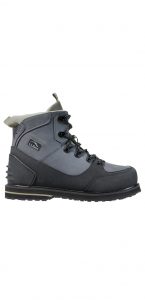 The metal studs on the grippy rubber soles of these boots are unobtrusive enough that these boots do super well in the field as well as in the stream. Their streamlined shape helps cut through slick underwater vegetation, and their high ankle support provides both comfort and safety.
The metal studs on the grippy rubber soles of these boots are unobtrusive enough that these boots do super well in the field as well as in the stream. Their streamlined shape helps cut through slick underwater vegetation, and their high ankle support provides both comfort and safety.
Price: $179.00
Features:
- Metal traction studs
- Rubber sole
- EVA foam midsole
Benefits
- Highly protective against torsion and debris
- Great traction without sacrificing maneuverability
- Nonabsorbent material for quick drying
Patagonia x Danner Foot Tractor Wading Boots– Aluminum Bar
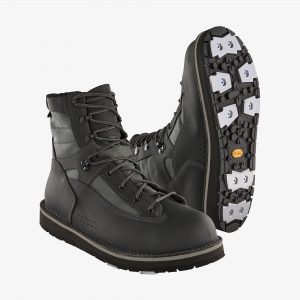 The aluminum bars on the Vibram rubber soles of these boots mean that once you’ve found your footing, you’re not going anywhere. Tough enough to cut through algae and slime but soft enough to conform to the shape of the river rocks, the Foot Tractor Wading Boots are a top boot option.
The aluminum bars on the Vibram rubber soles of these boots mean that once you’ve found your footing, you’re not going anywhere. Tough enough to cut through algae and slime but soft enough to conform to the shape of the river rocks, the Foot Tractor Wading Boots are a top boot option.
Price: $399.00
Features:
- Aluminum grip bars
- Full-grain leather
- Two other sole options
Benefits
- Stitch down construction means these boots can be resoled
- Quick drain/quick dry
- Leather stands up to salt water and can be reconditioned
The Best Wading Sandals
If you’re thinking about using sandals to wade, you must be aware of stream conditions. Sandals provide the least toe protection, and if you’re not careful, you can injure yourself. But if you’ve got a sandy bottom or slow-moving water, nothing is lighter than a pair of sandals.
Chaco ZCloud
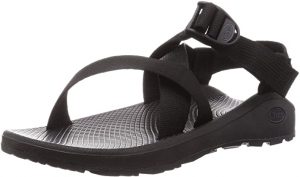 Sandals don’t get much more comfortable than the Chaco ZCloud. Their insoles are designed with podiatrist consultation for maximum comfort and support. The soles are solid rubber, and the straps wrap around the foot for maximized ankle support with a minimalist design.
Sandals don’t get much more comfortable than the Chaco ZCloud. Their insoles are designed with podiatrist consultation for maximum comfort and support. The soles are solid rubber, and the straps wrap around the foot for maximized ankle support with a minimalist design.
Price: $100
Features:
- Rubber soles
- Jacquard webbing straps
- PU midsoles for comfort
Benefits
- Podiatrist-approved arch support
- Comfortable fit
- Durable
Buy Men’s On Amazon | Buy On Chacos
Buy Women’s On Amazon | Buy Women’s On Chacos
KEEN Newport H2 Sandal
The KEEN Newport H2 might be the ultimate wading sandal, and here’s why: this sandal has a closed toe! The rubber toe cap protects your toes from getting stuck under rocks or cut on debris
Price: $110.00 (Price varies on Amazon)
Features:
- Rubber sole, toe, and heel caps
- Washable webbing upper
- Razor-siped sole
Benefits
- Great traction
- The airiness of a sandal with the toe protection of a shoe
- Versatile and comfortable
Buy Men’s On Amazon | Buy Men’s On Keen
Buy Women’s On Amazon | Buy Women’s On Keen
The Best Wet Wading Shoes
If you don’t like the weight of boots but want more ankle support than sandals can offer, wet wading shoes are for you. Some are styled more like a traditional water shoe; others are more akin to a hiking shoe or running shoe. Both styles offer good protection and several other benefits.
Frogg Toggs Aransas II Neoprene Surf And Sand Shoe
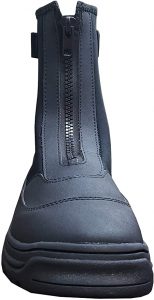 The Aransas II is the perfect shoe for water activities. Its reinforced toe and heel provide great protection, while the neoprene construction keeps your feet warm and safe. The adjustable ankle strap and full zipper gusset do a great job of keeping even the most minute debris out.
The Aransas II is the perfect shoe for water activities. Its reinforced toe and heel provide great protection, while the neoprene construction keeps your feet warm and safe. The adjustable ankle strap and full zipper gusset do a great job of keeping even the most minute debris out.
Price: $69.99 (price varies on Amazon)
Features:
- Anti-debris guards
- Athletic rubber sole for grip
- Neoprene upper
Benefits
- Lightweight
- Budget-friendly
- Versatile
Buy On Amazon | Buy On Frogg Toggs
Orvis PRO Approach Wading Shoes
 Many wet waders rave about the Orvis PRO Approach wading shoes. And for good reason– these shoes provide incredible water traction. That’s because their soles are made from tire-grade Michelin rubber to provide superior stability and grip on slippery surfaces. They’re lighter than boots and more supportive than sandals, but where the PRO Approach shines is its transitional nature. These shoes are comfortable enough to hike or go boating in, meaning you don’t have to carry another pair of shoes for your outdoor adventures.
Many wet waders rave about the Orvis PRO Approach wading shoes. And for good reason– these shoes provide incredible water traction. That’s because their soles are made from tire-grade Michelin rubber to provide superior stability and grip on slippery surfaces. They’re lighter than boots and more supportive than sandals, but where the PRO Approach shines is its transitional nature. These shoes are comfortable enough to hike or go boating in, meaning you don’t have to carry another pair of shoes for your outdoor adventures.
Price: $149.00
Features:
- Michelin rubber sole
- Integrated Ariaprene debris guard
Benefits
- Multipurpose
- Lightweight
- Comfortable
Best Waterproof Storage
One thing a wet wader might miss from dry wading is the wading belt and the convenient clip-on storage space it offers. Don’t worry– there are plenty of incredible waterproof storage options out there for you that won’t get in the way of your cast. While there are many dry bag options out there, here are two that are specifically designed for wading.
Wading inherently has the danger of an angler taking a dip and submerging under the water. Since most are carrying phones, non waterproof car keys, maybe cameras, and other electronics, we highly recommend either investing in a waterproof bag that can go inside your gear to hold items, or purchasing a waterproof fishing sling, chest pack, or hip pack. Patagonia, Fishpond and Orvis each make fly packs that are waterproof and high quality.
Here are a few solid options to consider, but know that many brands produce high quality packs now:
Fishpond Thunderhead Submersible Sling
Many anglers like the freedom of movement that a sling pack provides. Fishpond’s Thunderhead line of submersible storage isn’t just waterproof, it’s virtually indestructible. Made from bombproof recycled nylon, the Thunderhead submersible sling features gear straps, an integrated net slot, a small water-resistant outer pocket, and a large, secure inner compartment for your tackle and valuables.
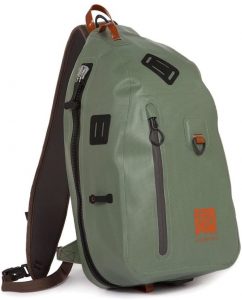 Fishpond also makes a backpack, a chest pack, and a lumbar pack, all of which are completely waterproof, if a sling isn’t your style. Fishpond makes super high quality gear and we recommend almost anything they produce.
Fishpond also makes a backpack, a chest pack, and a lumbar pack, all of which are completely waterproof, if a sling isn’t your style. Fishpond makes super high quality gear and we recommend almost anything they produce.
Price: $229.95
Features:
- Waterproof TIZIP closure
- Padded foam strap
- Completely waterproof interior pouch
Benefits
- Lightweight
- Comfortable
- Sturdy
Buy On Amazon | Buy On Fishpond USA
Umpqua Rock Creek ZS2 Chest Pack Or Similar
 Designed with the fly fisher in mind, don’t be fooled by the Rock Creek ZS2’s small size- it can easily hold two standard fly boxes, and the ZeroSweep retractor stations are perfect for your favorite accessories. The Rock Creek ZS2 also has two ambidextrous hemostat grab tabs, a foam fly patch station, a stowable cord tippet holder, and a Molle modular attachment station should you need to carry additional gear.
Designed with the fly fisher in mind, don’t be fooled by the Rock Creek ZS2’s small size- it can easily hold two standard fly boxes, and the ZeroSweep retractor stations are perfect for your favorite accessories. The Rock Creek ZS2 also has two ambidextrous hemostat grab tabs, a foam fly patch station, a stowable cord tippet holder, and a Molle modular attachment station should you need to carry additional gear.
Chest packs are preferred by some anglers. This one isn’t fully waterproof but does sit high, and therefore is protected unless you take a dip.
Price: $69.99
Features:
- Multiple retractor stations
- Ballistic nylon construction
- Front carriage for easy access
Benefits
- Compact
- Durable
- Versatile
We hope that this guide has encouraged you to go out and give wet wading a try!
Max DesMarais is the founder of hikingandfishing.com. He has a passion for the outdoors and making outdoor education and adventure more accessible. Max is a published author for various outdoor adventure, travel, and marketing websites. He is an experienced hiker, backpacker, fly fisherman, backcountry skier, trail runner, and spends his free time in the outdoors. These adventures allow him to test gear, learn new skills, and experience new places so that he can educate others. Max grew up hiking all around New Hampshire and New England. He became obsessed with the New Hampshire mountains, and the NH 48, where he guided hikes and trail runs in the White Mountains. Since moving out west, Max has continued climbed all of the Colorado 14ers, is always testing gear, learning skills, gaining experience, and building his endurance for outdoor sports. You can read more about his experience here: hikingandfishing/about
